Supply and Demand Patterns Investigations of Water Supply Services Based on Ecosystem Service Flows in a Mountainous Area: Taihang Mountains Case Study
Abstract
:1. Introduction
2. Materials and Methods
2.1. Study Area
2.2. Data Sources
2.3. Research Methodology
2.3.1. Assessment of Water Supply Service Supply
2.3.2. Model Verification
2.3.3. Assessment of Water Supply Service Demand
2.3.4. Quantification of Water Supply Service Flows
2.3.5. Global Spatial Autocorrelation of Water Supply Service Supply, Demand, and Flow
3. Results
3.1. Water Supply Service Supply and Demand
3.1.1. Water Supply Service Supply
3.1.2. Water Supply Service Demand
3.2. Water Supply Service Flows
3.2.1. Water Supply Service Flow Characteristics
3.2.2. Spatial Distribution Characteristics of Water Supply Service Flows
3.3. Characteristics of Supply and Demand Pattern of Water Supply Services Based on Ecosystem Service Flows
4. Discussion
4.1. The Difference between Water Supply Service Flow and Water Physical Flow
4.2. Factors Influencing the Supply and Demand Patterns of Water Supply Services
4.3. Suggestions for the Rational Utilization of Water Resources Based on the Supply and Demand Patterns of Water Supply Services
5. Conclusions
Author Contributions
Funding
Institutional Review Board Statement
Informed Consent Statement
Data Availability Statement
Conflicts of Interest
References
- Song, X.F.; Li, F.D.; Liu, C.M.; Tang, C.Y.; Zhang, Q.Y.; Zhang, W.J. Water cycle in Taihang Mountain and its recharge to groundwater in North China Plain. J. Nat. Resour. 2007, 22, 398–408. (In Chinese) [Google Scholar]
- Hu, Y.S.; Zhai, H.B.; Tian, Y. Analysis on sustainability of Taihang Mountain greening construction. For. Econ. 2017, 39, 48–52. (In Chinese) [Google Scholar]
- Huang, M.D.; Xiao, Y.; Xu, J.; Liu, J.Y.; Wang, Y.Y.; Gan, S.; Lv, S.X.; Xie, G.D. A review on the supply-demand relationship and spatial flows of ecosystem services. J. Resour. Ecol. 2022, 13, 925–935. [Google Scholar]
- Yang, Y.H.; Wang, Z.P.; Sakura, Y.S.; Tang, C.Y.; Shindo, S.Z. Effects of global warming on productivity and soil moisture in Taihang Mountain. Chin. J. Appl. Ecol. 2002, 13, 667–671. (In Chinese) [Google Scholar]
- Song, X.F.; Wang, P.; Yu, J.J.; Liu, X.; Liu, J.R.; Yuan, R.Q. Relationships between precipitation, soil water and groundwater at Chongling catchment with the typical vegetation cover in the Taihang mountainous region, China. Environ. Earth Sci. 2011, 62, 787–796. [Google Scholar] [CrossRef]
- Zhu, J.J.; Liu, J.T.; Liang, H.Z.; Gao, H.; Liu, P. Vertical gradients of water supply and demand in Taihang Mountains, China. Chin. J. Appl. Ecol. 2019, 30, 472–480. (In Chinese) [Google Scholar]
- Meisch, C.; Schirpke, U.; Huber, L.; Rüdisser, J.; Tappeiner, U. Assessing freshwater provision and consumption in the alpine space applying the ecosystem service concept. Sustainability 2019, 11, 1131. [Google Scholar] [CrossRef]
- Grêt-Regamey, A.; Weibel, B. Global assessment of mountain ecosystem services using earth observation data. Ecosyst. Serv. 2020, 46, 101213. [Google Scholar] [CrossRef]
- Immerzeel, W.W.; Lutz, A.F.; Andrade, M.; Bahl, A.; Biemans, H.; Bolch, T.; Hyde, S.; Brumby, S.; Davies, B.J.; Elmore, A.C.; et al. Importance and vulnerability of the world’s water towers. Nature 2020, 577, 364–384. [Google Scholar] [CrossRef]
- Deng, W.; Dai, E.F.; Jia, Y.W.; Chen, H.S.; Xiong, D.H.; Shi, P.L. Spatiotemporal coupling characteristics, effects and their regulation of water and soil elements in mountainous area. Mt. Res. 2015, 33, 513–520. (In Chinese) [Google Scholar]
- Rogora, M.; Frate, L.; Carranza, M.L.; Freppaz, M.; Stanisci, A.; Bertani, I.; Bottarin, R.; Brambilla, A.; Canullo, R.; Carbognani, M.; et al. Assessment of climate change effects on mountain ecosystems through a cross-site analysis in the Alps and Apennines. Sci. Total Environ. 2018, 624, 1429–1442. [Google Scholar] [CrossRef]
- Zhang, Z.; Peng, J.; Xu, Z.H.; Wang, X.Y.; Meersmans, J. Ecosystem services supply and demand response to urbanization: A case study of the Pearl River Delta, China. Ecosyst. Serv. 2021, 49, 101274. [Google Scholar] [CrossRef]
- Wang, J.; Zhai, T.L.; Lin, Y.F.; Kong, X.S.; He, L. Spatial imbalance and changes in supply and demand of ecosystem services in China. Sci. Total Environ. 2019, 657, 781–791. [Google Scholar] [CrossRef]
- Bai, Y.; Ochuodha, T.O.; Yang, J. Impact of land use and climate change on water-related ecosystem services in Kentucky, USA. Ecol. Indic. 2019, 102, 51–64. [Google Scholar] [CrossRef]
- Wen, Y.L.; Li, H.B.; Zhang, X.L.; Li, T.Y. Ecosystem services in Jiangsu province: Changes in the supply and demand patterns and its influencing factors. Front. Environ. Sci. 2022, 10, 931735. [Google Scholar] [CrossRef]
- Sinare, H.; Gordon, L.J.; Kautsky, E.E. Assessment of ecosystem services and benefits in village landscapes—A case study from Burkina Faso. Ecosyst. Serv. 2016, 21, 141–152. [Google Scholar] [CrossRef]
- Brander, L.M.; Tankha, S.; Sovann, C.; Sanadiradze, G.; Zazanashvili, N.; Kharazishvili, D.; Memiadze, N.; Osepashvili, I.; Beruchashvili, G.; Arobelidze, N. Mapping the economic value of landslide regulation by forests. Ecosyst. Serv. 2018, 32, 101–109. [Google Scholar] [CrossRef]
- Sharafatmandrad, M.; Mashizi, A.K. Temporal and Spatial Assessment of Supply and Demand of the Water-yield Ecosystem Service for Water Scarcity Management in Arid to Semi-arid Ecosystems. Water Resour. Manag. 2021, 35, 63–82. [Google Scholar] [CrossRef]
- Zhu, Q.; Tran, L.T.; Wang, Y.; Qi, L.; Zhou, W.M.; Zhou, L.; Yu, D.P.; Dai, L.M. A framework of freshwater services flow model into assessment on water security and quantification of transboundary flow: A case study in northeast China. J. Environ. Manag. 2022, 304, 114318. [Google Scholar] [CrossRef]
- Wang, Z.Z.; Zhang, L.W.; Li, X.P.; Li, Y.J.; Wang, P.T.; Yan, J.P. Spatio-temporal pattern of supply-demand risk of ecosystem services at regional scale: A case study of water yield service in Shaanxi province. Acta Ecol. Sin. 2020, 40, 1887–1900. (In Chinese) [Google Scholar]
- Wu, Y.F.; Xu, Y.; Yin, G.D.; Zhang, X.; Li, C.; Wu, L.Y.; Wang, X.; Hu, Q.H.; Hao, F.H. A collaborated framework to improve hydrologic ecosystem services management with sparse data in a semi-arid basin. Hydrol. Res. 2021, 52, 1159–1172. [Google Scholar] [CrossRef]
- Worku, G.; Teferi, E.; Bantider, A.; Dile, Y.T. Modelling hydrological processes under climate change scenarios in the Jemma sub-basin of upper Blue Nile Basin, Ethiopia. Clim. Risk Manag. 2021, 31, 100272. [Google Scholar] [CrossRef]
- Li, D.L.; Wu, S.Y.; Liu, L.B.; Liang, Z.; Li, S.C. Evaluating regional water security through a freshwater ecosystem service flow model: A case study in Beijing-Tianjin-Hebei region, China. Ecol. Indic. 2017, 81, 159–170. [Google Scholar] [CrossRef]
- Sun, S.Q.; Lü, Y.H.; Fu, B.J. Relations between physical and ecosystem service flows of freshwater are critical for water resource security in large dryland river basin. Sci. Total Environ. 2023, 857, 159549. [Google Scholar] [CrossRef] [PubMed]
- Mehring, M.; Ott, E.; Hummel, D. Ecosystem services supply and demand assessment: Why social-ecological dynamics matter. Ecosyst. Serv. 2018, 30, 124–125. [Google Scholar] [CrossRef]
- Zhang, H.J.; Feng, J.; Zhang, Z.C.; Liu, K.; Gao, X.; Wang, Z.D. Regional spatial management based on supply-demand risk of ecosystem services-a case study of the Fenghe River watershed. Int. J. Environ. Res. Public Health 2020, 17, 4112. [Google Scholar] [CrossRef]
- Thakur, B.K.; Bal, D.P.; Nurujjaman, M.; Debnath, K. Developing a model for residential water demand in the Indian Himalayan Region of Ravangla, South Sikkim, India. Groundw. Sustain. Dev. 2023, 21, 100923. [Google Scholar] [CrossRef]
- Chen, Y.M.; Zhai, Y.P.; Gao, J.X. Spatial patterns in ecosystem services supply and demand in the Jing-Jin-Ji region, China. J. Clean. Prod. 2022, 361, 132177. [Google Scholar] [CrossRef]
- Gao, Y.; Feng, Z.; Li, Y.; Li, S.C. Freshwater ecosystem service footprint model: A model to evaluate regional freshwater sustainable development—A case study in Beijing–Tianjin–Hebei, China. Ecol. Indic. 2014, 39, 1–9. [Google Scholar] [CrossRef]
- Lin, J.Y.; Huang, J.L.; Prell, C.; Bryan, B.A. Changes in supply and demand mediate the effects of land-use change on freshwater ecosystem services flows. Sci. Total Environ. 2021, 763, 143012. [Google Scholar] [CrossRef]
- Chen, D.S.; Li, J.; Yang, X.N.; Zhou, Z.X.; Pan, Y.Q.; Li, M.C. Quantifying water provision service supply, demand and spatial flow for land use optimization: A case study in the YanHe watershed. Ecosyst. Serv. 2020, 43, 101117. [Google Scholar] [CrossRef]
- Qi, F.; Liu, J.T.; Gao, H.; Fu, T.G.; Wang, F. Characteristics and spatial-temporal patterns of supply and demand of ecosystem services in the Taihang Mountains. Ecol. Indic. 2023, 147, 109932. [Google Scholar] [CrossRef]
- Wu, A.B.; Zhang, J.W.; Zhao, Y.X.; Shen, H.T.; Guo, X.P. Simulation and Optimization of Supply and Demand Pattern of Multiobjective Ecosystem Services—A Case Study of the Beijing-Tianjin-Hebei Region. Sustainability 2022, 14, 2658. [Google Scholar] [CrossRef]
- Liu, J.Y.; Qin, K.Y.; Xie, G.D.; Xiao, Y.; Huang, M.D.; Gan, S. Is the ‘water tower’ reassuring? Viewing water security of Qinghai-Tibet Plateau from the perspective of ecosystem services ‘supply-flow-demand’. Environ. Res. Lett. 2022, 17, 094043. [Google Scholar] [CrossRef]
- Fu, T.G.; Han, L.P.; Gao, H.; Liang, H.Z.; Liu, J.T. Geostatistical analysis of pedodiversity in Taihang Mountain region in North China. Geoderma 2018, 328, 91–99. [Google Scholar] [CrossRef]
- Gao, H.; Fu, T.G.; Liu, J.T.; Liang, H.Z.; Han, L.P. Ecosystem services management based on differentiation and regionalization along vertical gradient in Taihang Mountain, China. Sustainability 2018, 10, 986. [Google Scholar] [CrossRef]
- Xu, J.; Xiao, Y.; Xie, G.D.; Jiang, Y. Ecosystem Service Flow Insights into Horizontal Ecological Compensation Standards for Water Resource: A Case Study in Dongjiang Lake Basin, China. Chin. Geogr. Sci. 2019, 29, 214–230. [Google Scholar] [CrossRef]
- Ping, J.L.; Green, C.L.; Zartman, R.E.; Bronson, K.F. Exploring spatial dependence of cotton yield using global and local autocorrelation statistics. Field Crops Res. 2004, 89, 219–236. [Google Scholar] [CrossRef]
- Tan, H.; Liu, Z.; Rao, W.; Wei, H.Z.; Zhang, Y.D.; Jin, B. Stable isotopes of soil water: Implications for soil water and shallow groundwater recharge in hill and gully regions of the Loess Plateau, China. Agric. Ecosyst. Environ. 2017, 243, 1–9. [Google Scholar] [CrossRef]
- Wilkerson, M.L.; Mitchell MG, E.; Shanahan, D.; Wilson, K.A.; Ives, C.D.; Lovelock, C.E.; Rhodes, J.R. The role of socio-economic factors in planning and managing urban ecosystem services. Ecosyst. Serv. 2018, 31, 102–110. [Google Scholar] [CrossRef]
- Chen, J.Y.; Jiang, B.; Bai, Y.; Xu, X.B.; Alatalo, J.M. Quantifying ecosystem services supply and demand shortfalls and mismatches for management optimization. Sci. Total Environ. 2019, 650, 1426–1439. [Google Scholar] [CrossRef]
- Wu, X.; Liu, S.L.; Zhao, S.; Hou, X.Y.; Xu, J.W.; Dong, S.K.; Liu, G.H. Quantification and driving force analysis of ecosystem services supply, demand and balance in China. Sci. Total Environ. 2019, 652, 1375–1386. [Google Scholar] [CrossRef]
- Delphin, S.; Escobedo, F.; Abd-Elrahman, A.; Cropper, W.P. Urbanization as a land use change driver of forest ecosystem services. Land Use Policy 2016, 54, 188e199. [Google Scholar] [CrossRef]
- Zhao, X.J.; Su, J.D.; Wang, J.; Jin, W.Q.; Chen, E.; Zhang, J.; Xiang, M. A study on the relationship between supply-demand relationship of ecosystem services and impact factors in Gansu Province. China Environ. Sci. 2021, 41, 4926–4941. (In Chinese) [Google Scholar]
- Xu, J.; Xiao, Y.; Xie, G.; Liu, J.Y.; Qin, K.Y.; Wang, Y.Y.; Zhang, C.S.; Lei, G.C. How to coordinate cross-regional water resource relationship by integrating water supply services flow and interregional ecological compensation. Ecol. Indic. 2021, 126, 107595. [Google Scholar] [CrossRef]
- Huang, Y.L.; Chen, L.D.; Fu, B.J.; Zhang, L.P.; Wang, Y.L. Evapotranspiration and soil moisture balance for vegetative restoration in a gully catchment on the loess plateau, China. Pedosphere 2005, 15, 509–517. [Google Scholar]
- Wang, S.; Li, Q.; Wang, J. Quantifying the contributions of climate change and human activities to the dramatic reduction in runoff the Taihang Mountain region, China. Apply Ecol. Environ. Res. 2021, 19, 119–131. [Google Scholar] [CrossRef]
- Gao, J.; Zhuo, L.; Duan, X.M.; Wu, P.T. Agricultural water-saving potentials with water footprint benchmarking under different tillage practices for crop production in an irrigation district. Agric. Water Manag. 2023, 282, 108274. [Google Scholar] [CrossRef]
- Toumi, I.; Ghrab, M.; Nagaz, K. Vegetative growth, yield, and water productivity of an early maturing peach cultivar under deficit irrigation strategies in a warm and arid area. Irrig. Drain. 2022, 71, 938–947. [Google Scholar] [CrossRef]
- Yao, J.P.; Wang, G.Q.; Jiang, X.M.; Xue, B.L.; Wang, Y.T.; Duan, L.M. Exploring the spatiotemporal variations in regional rainwater harvesting potential resilience and actual available rainwater using a proposed method framework. Sci. Total Environ. 2023, 858, 160005. [Google Scholar] [CrossRef]
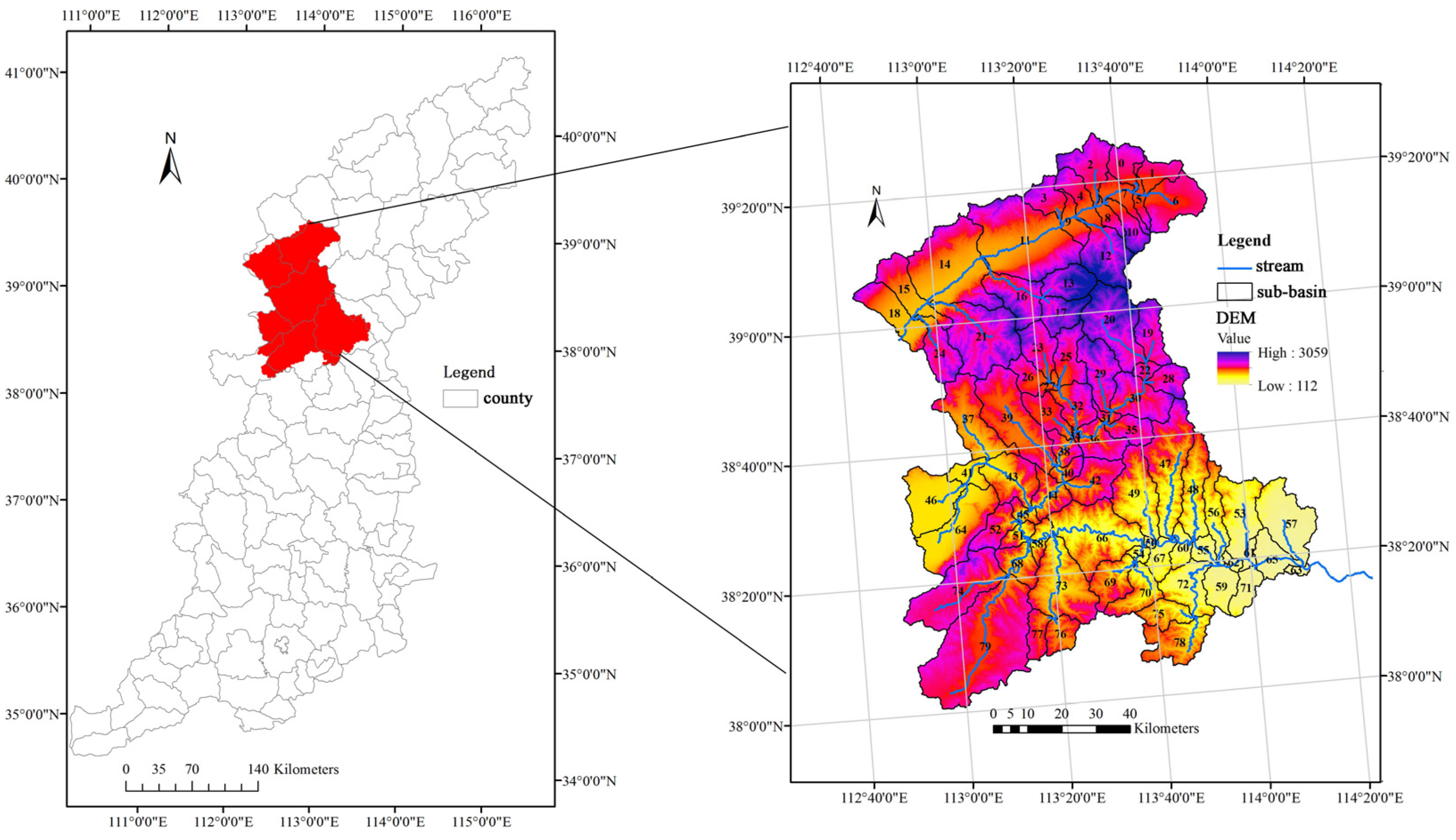


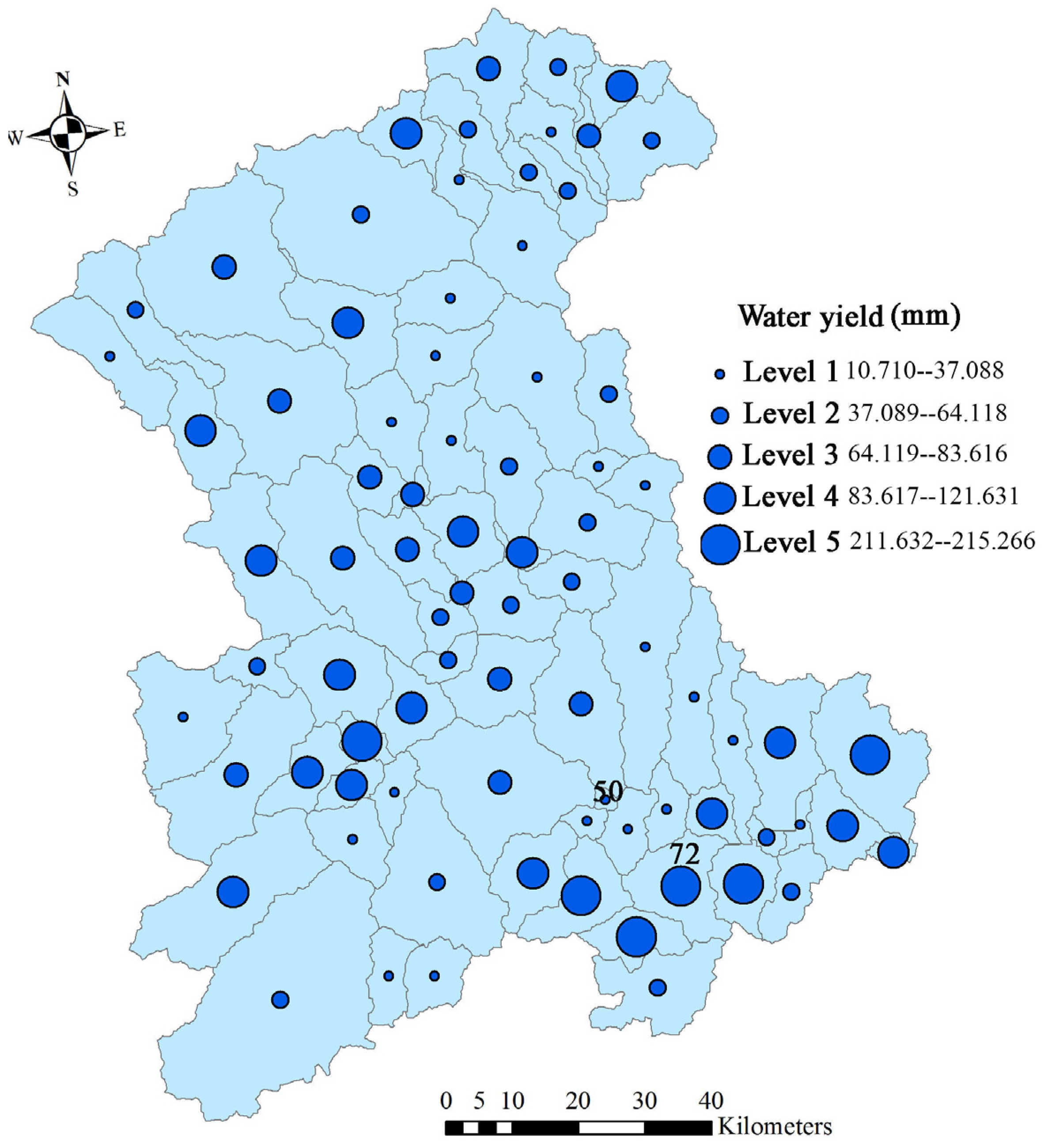
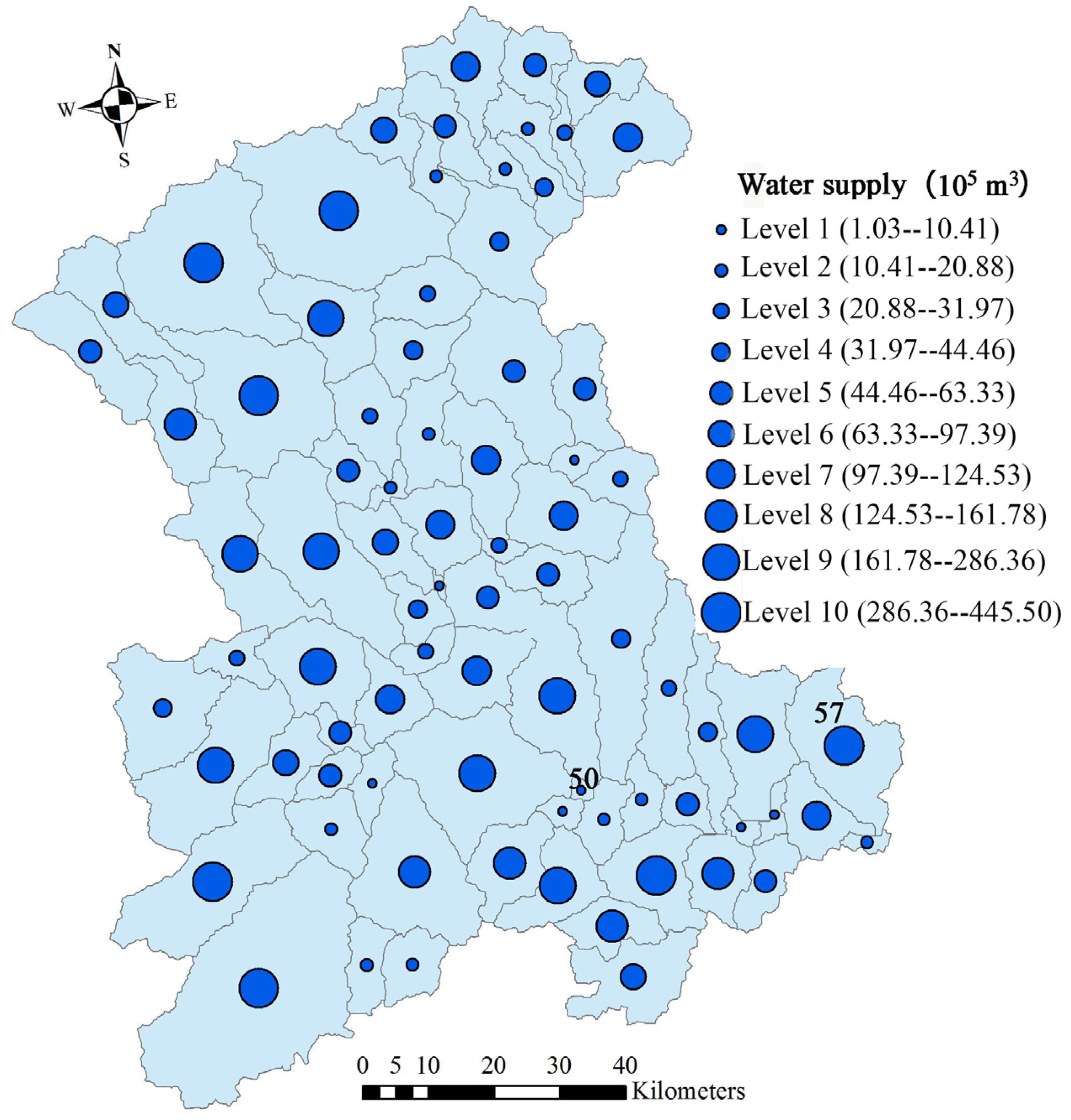

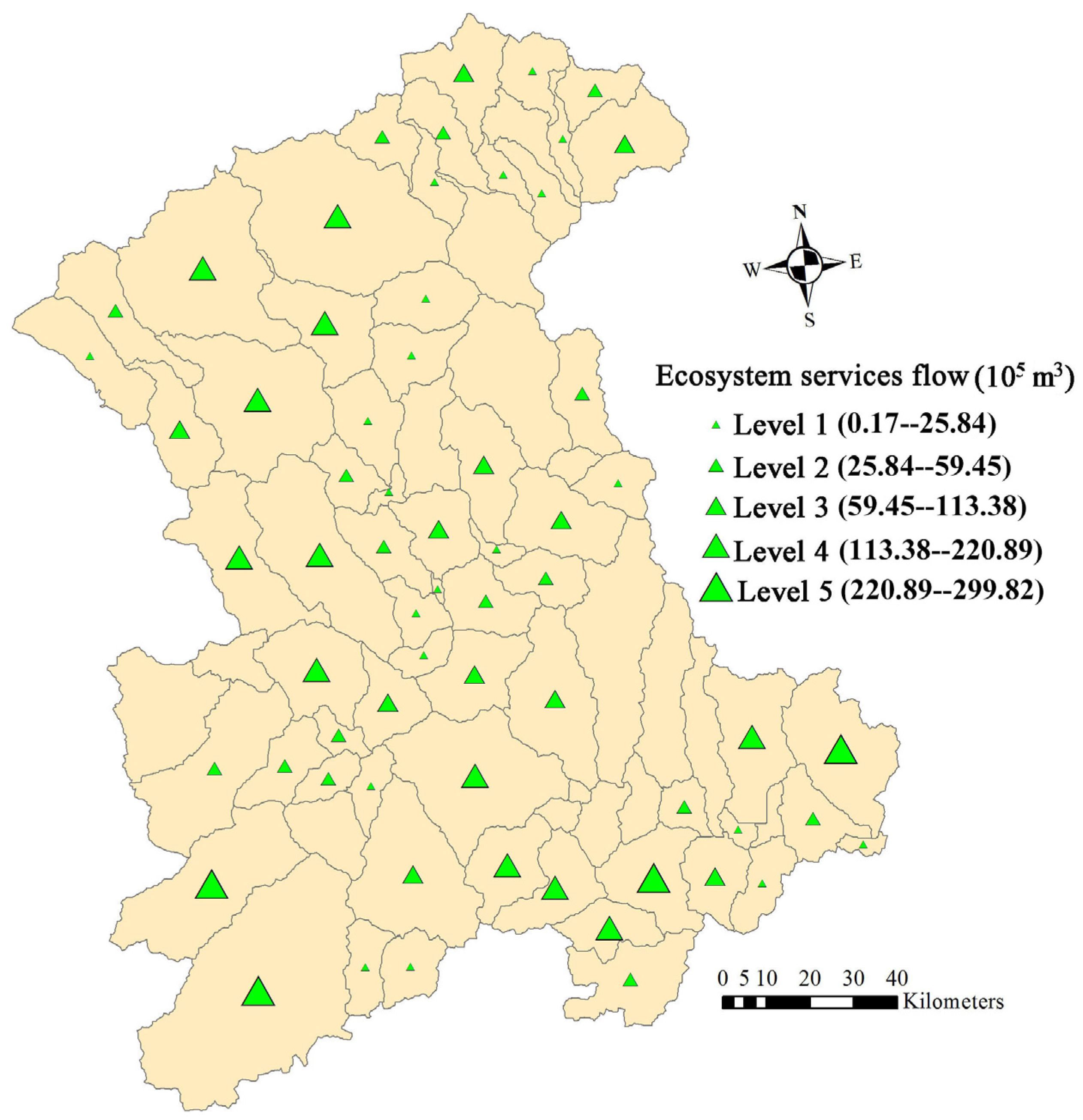

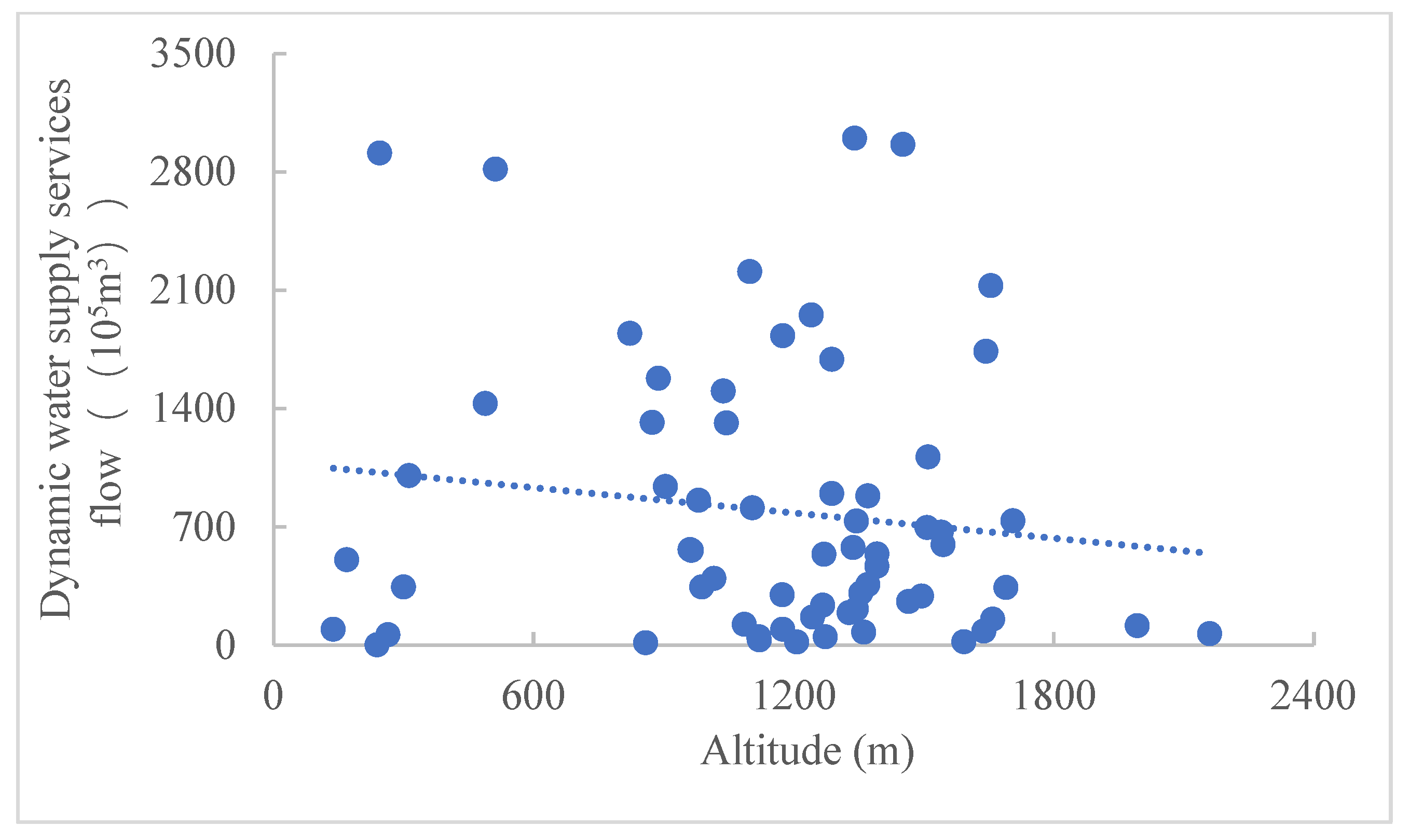
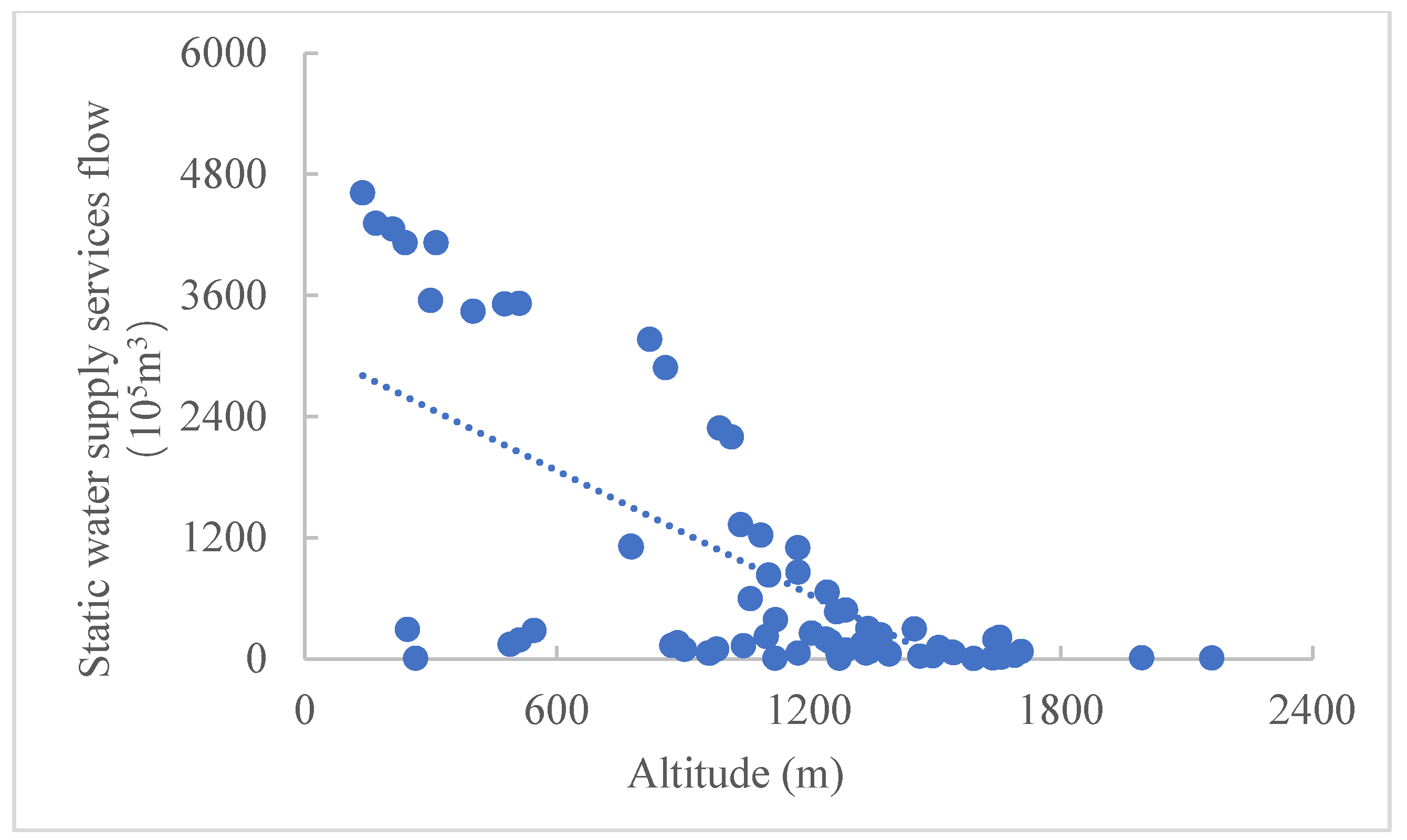


| Abbreviation | Description |
|---|---|
| MODIS | Moderate-resolution imaging spectroradiometer |
| MOD16 | MODIS Global Evapotranspiration Project (MOD16) |
| NASA | National Aeronautics and Space Administration |
| InVEST | Integrated valuation of ecosystem services and tradeoffs |
| TM | Thematic mapper |
| DEM | Digital Elevation Model |
| City/Time | 2013 | 2014 | 2015 | 2016 | 2017 | Average |
|---|---|---|---|---|---|---|
| Yizhou city | 205 | 206 | 212 | 211 | 210 | 209 |
| Taiyuan city | 176 | 170 | 173 | 179 | 177 | 175 |
| Yangquan city | 163 | 154 | 139 | 131 | 132 | 144 |
| Shijiazhuang city | 261 | 261 | 252 | 244 | 241 | 252 |
Disclaimer/Publisher’s Note: The statements, opinions and data contained in all publications are solely those of the individual author(s) and contributor(s) and not of MDPI and/or the editor(s). MDPI and/or the editor(s) disclaim responsibility for any injury to people or property resulting from any ideas, methods, instructions or products referred to in the content. |
© 2023 by the authors. Licensee MDPI, Basel, Switzerland. This article is an open access article distributed under the terms and conditions of the Creative Commons Attribution (CC BY) license (https://creativecommons.org/licenses/by/4.0/).
Share and Cite
Gao, H.; Fu, T.; Zhu, J.; Wang, F.; Zhang, M.; Qi, F.; Liu, J. Supply and Demand Patterns Investigations of Water Supply Services Based on Ecosystem Service Flows in a Mountainous Area: Taihang Mountains Case Study. Sustainability 2023, 15, 13248. https://doi.org/10.3390/su151713248
Gao H, Fu T, Zhu J, Wang F, Zhang M, Qi F, Liu J. Supply and Demand Patterns Investigations of Water Supply Services Based on Ecosystem Service Flows in a Mountainous Area: Taihang Mountains Case Study. Sustainability. 2023; 15(17):13248. https://doi.org/10.3390/su151713248
Chicago/Turabian StyleGao, Hui, Tonggang Fu, Jianjia Zhu, Feng Wang, Mei Zhang, Fei Qi, and Jintong Liu. 2023. "Supply and Demand Patterns Investigations of Water Supply Services Based on Ecosystem Service Flows in a Mountainous Area: Taihang Mountains Case Study" Sustainability 15, no. 17: 13248. https://doi.org/10.3390/su151713248
APA StyleGao, H., Fu, T., Zhu, J., Wang, F., Zhang, M., Qi, F., & Liu, J. (2023). Supply and Demand Patterns Investigations of Water Supply Services Based on Ecosystem Service Flows in a Mountainous Area: Taihang Mountains Case Study. Sustainability, 15(17), 13248. https://doi.org/10.3390/su151713248






